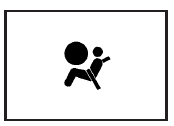Airbag System
Your vehicle has a frontal airbag for the driver and a frontal airbag for the right front passenger.
Your vehicle may also have roof-mounted side impact airbags designed for either side impact or rollover deployment. Roof-mounted side impact airbags are available for the driver and the passenger seated directly behind the driver and for the right front passenger and the passenger seated directly behind that passenger.
If your vehicle has roof-mounted side impact airbags, the word AIRBAG will appear on the airbag covering on the sidewall trim near the driver’s and right front passenger’s window.
Even if you have no right front passenger seat in your vehicle there is still an active frontal airbag in the right side of the instrument panel. Do not place cargo in front of this airbag.
CAUTION:
Be sure that cargo is not near an airbag.
In a crash, an inflating airbag might force
that object toward a person. This could
cause severe injury or even death.
Secure objects away from the area in
which an airbag would inflate. For more
information, see Where Are the Airbags?
on page 71 and Loading Your Vehicle
on page 330.
Airbags are designed to supplement the protection provided by safety belts. Even though today’s airbags are also designed to help reduce the risk of injury from the force of an inflating bag, all airbags must inflate very quickly to do their job.
Here are the most important things to know about the airbag system:
CAUTION:
You can be severely injured or killed in a
crash if you are not wearing your safety
belt — even if you have airbags. Wearing
your safety belt during a crash helps
reduce your chance of hitting things
inside the vehicle or being ejected from it.
Airbags are “supplemental restraints” to
the safety belts. All airbags are designed
to work with safety belts but do not
replace them.
Frontal airbags for the driver and right
front passenger are designed to deploy
in moderate to severe frontal and near
frontal crashes. They are not designe to inflate in rollover, rear crashes, or
in
many side crashes. And, for some
unrestrained occupants, frontal airbags
may provide less protection in frontal
crashes than more forceful airbags have
provided in the past.
Roof-mounted side impact airbags are
designed to inflate in moderate to severe
crashes where something hits the side of
your vehicle. They are not designed to
inflate in frontal or in rear crashes. If the
vehicle is equipped with rollover capable
airbags, it has been designed to deploy
the roof-mounted side impact airbags in
the event of a vehicle rollover. Everyone
in your vehicle should wear a safety belt
properly — whether or not there is an
airbag for that person.
CAUTION:
Both frontal and roof-mounted side impact
airbags inflate with great force, faster than
the blink of an eye. If you are too close to
an inflating airbag, as you would be if you
were leaning forward, it could seriously
injure you. Safety belts help keep you in
position for airbag inflation before and
during a crash. Always wear your safety
belt even with frontal airbags. The driver
should sit as far back as possible while
still maintaining control of the vehicle.
Occupants should not lean on or sleep
against the door.
CAUTION:
Anyone who is up against, or very close
to, any airbag when it inflates can be
seriously injured or killed. Airbags plus
lap-shoulder belts offer the best
protection for adults, but not for young
children and infants. Neither the vehicle’s
safety belt system nor its airbag system is
designed for them. Young children and
infants need the protection that a child
restraint system can provide. Always
secure children properly in your vehicle.

There is an airbag readiness light on the instrument panel cluster, which shows the airbag symbol.
The system checks the airbag electrical system for malfunctions. The light tells you if there is an electrical problem.
See also:
Charging System Light
The charging system light comes on briefly when the ignition is turned on, but the engine is not running, as a check to show the light is working.
The light turns off when the engine is started. If ...
High Voltage Safety Information
eAssist vehicles have a standard
12-volt battery and a high voltage
battery. Only a trained service
technician with the proper
knowledge and tools should inspect,
test, or replace the high v ...
Headlamp Aiming
The headlamp aiming system has
been preset at the factory.
If the vehicle is damaged in an
accident, the aim of the headlamps
may be affected and adjustment
may be necessary.
It is recommend ...


